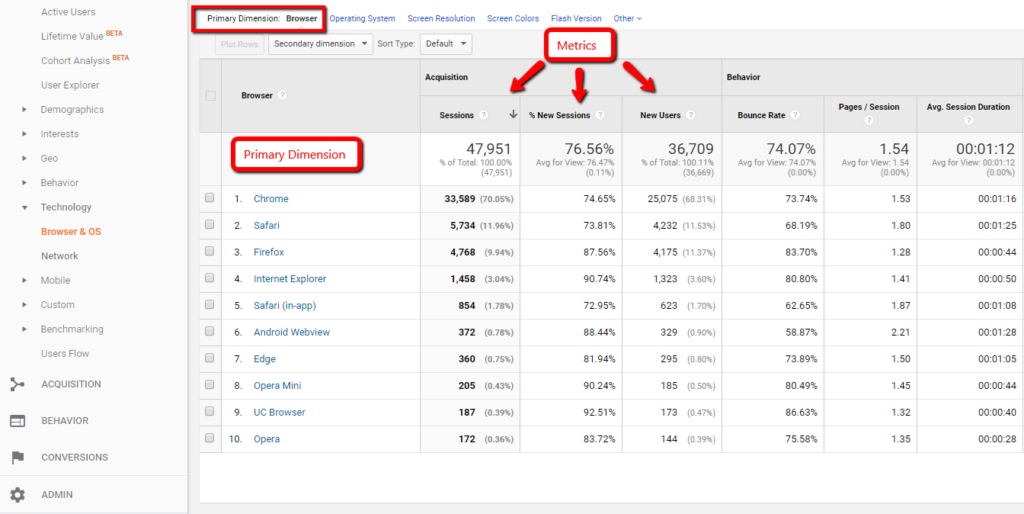Deciphering the Value of Secondary Measurement in Google Analytics: All Regarding Its Significance and Impact
In the realm of electronic analytics, the use of second dimensions within Google Analytics serves as a critical device for critical deeper layers of information insights. The value of second measurements lies in their capacity to provide a nuanced sight of individual habits and interaction with a web site or system.
Understanding Secondary Dimensions in Google Analytics
The understanding of second measurements in Google Analytics is essential for acquiring deeper insights right into user habits and web site performance. While primary measurements give fundamental information factors such as website traffic resources and page sights, second measurements enable a more nuanced evaluation by providing extra context to these key metrics. By incorporating additional dimensions, individuals can segment and filter their information to uncover patterns and patterns that might not be promptly noticeable.

Introducing the Perks of Second Dimensions
Structure upon the fundamental understanding of second measurements in Google Analytics, exploring the benefits they provide exposes very useful insights for enhancing data analysis and decision-making. By integrating secondary dimensions, users can delve much deeper right into their information, getting an extra thorough sight of customer actions, material efficiency, and other essential metrics.
In addition, second measurements offer context to main information, providing additional layers of info that can assist in understanding customer communications and preferences. This enhanced understanding can lead critical decision-making, resulting in even more targeted advertising and marketing campaigns, website optimizations, and total improved efficiency. Basically, second measurements act as an effective tool for opening much deeper insights and making the most of the energy of Google Analytics for companies and site proprietors.
Leveraging Second Measurements for Boosted Insights
By taking advantage of the power of secondary dimensions in Google Analytics, organizations can reveal much deeper insights that drive educated tactical and decision-making optimization initiatives. Leveraging additional measurements enables companies to dive past surface-level data and obtain a more detailed understanding of user actions, target market demographics, web traffic sources, and site efficiency. By integrating primary dimensions like traffic sources with second measurements such as geographic place or tool classification, services can identify which areas or devices are driving the most important website traffic to their site.
Furthermore, second measurements allow businesses to sector and evaluate information much more successfully, assisting them identify patterns, patterns, and opportunities that may have or else gone undetected. By utilizing secondary dimensions, companies can tailor their marketing techniques, web content, and user experience to much better satisfy the requirements and choices of their target market. Essentially, leveraging second dimensions in Google Analytics empowers companies to make data-driven decisions that cause improved performance, raised ROI, and sustainable their website growth.

Influence of Additional Measurements on Information Evaluation
Enhancing information evaluation through the utilization of additional dimensions in Google Analytics supplies companies with a deeper understanding of their online performance metrics. By including second dimensions, such as time of day, geographical area, or gadget category, businesses can uncover valuable understandings that might have been overlooked with primary dimensions alone. This boosted degree of granularity allows for even more accurate division of data, allowing services to recognize patterns, patterns, and relationships that can drive critical decision-making.

Making Best Use Of Possible: Secondary Capacities Techniques
The tactical use of secondary dimensions in Google click here to read Analytics prolongs past boosting information evaluation; it includes crafting targeted approaches to unlock the complete capacity of valuable understandings for organization development. By using secondary dimensions properly, services can dig deeper right into their web site web traffic, individual behavior, and marketing projects to extract actionable understandings. One essential strategy is to combine second dimensions with key measurements to gain a detailed sight of user interactions. As an example, coupling the main dimension of 'source/medium' with additional dimensions like 'landing web page' or 'device group' can disclose which networks are driving traffic to details pages or exactly how user behavior differs across tools.
Additionally, utilizing second dimensions to segment information based upon user demographics, habits, or modern technology can aid businesses tailor their marketing initiatives to certain target market sections. This targeted technique can result in enhanced conversion rates, enhanced customer experiences, and ultimately, enhanced ROI. By making the most of the possibility of additional dimensions in Google Analytics, businesses can make enlightened decisions, enhance their online existence, and drive sustainable development.
Final Thought
Finally, second dimensions in Google Analytics play a vital function in offering deeper insights and boosting data evaluation. By using secondary measurements effectively, organizations can get a much more thorough understanding of user actions and web site efficiency. Incorporating additional dimensions right into data evaluation techniques can lead to more informed decision-making and enhanced total performance. It is necessary for businesses to take advantage of the power of second dimensions to maximize their prospective and achieve greater success in their online endeavors (what is a “secondary dimension” in google analytics?).
While main measurements provide fundamental information points such as web traffic resources and page sights, additional measurements enable for an extra nuanced evaluation by providing extra context to these main metrics. By incorporating key measurements like web traffic sources with second dimensions such as geographical place or device category, organizations can determine which tools or regions are driving the most beneficial traffic to their website.
By including secondary dimensions, such as time of day, geographic area, or gadget group, services can discover important understandings that may have been ignored with primary measurements alone. One crucial method is to integrate second dimensions with key dimensions to obtain a detailed sight of customer interactions. Pairing the key measurement of 'source/medium' with second measurements like 'landing web page' or 'device category' can expose which channels are driving traffic to particular web pages or just how individual habits varies throughout devices.